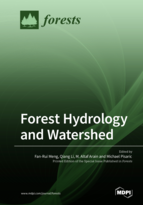Forest Hydrology and Watershed
A special issue of Forests (ISSN 1999-4907). This special issue belongs to the section "Forest Ecophysiology and Biology".
Deadline for manuscript submissions: closed (31 January 2019) | Viewed by 45659
Special Issue Editors
Interests: hydrology; ecological modelling; watershed management; GIS and landscape analysis; forest growth and yield models
Special Issues, Collections and Topics in MDPI journals
Interests: hydrometeorology; forest hydrology; evaporation; forest carbon cycle; managed forests; afforestation; eddy covariance technique; ecosystem models; land surface atmosphere interaction models
Interests: land cover and land use change; climate change; hydrological modelling; baseflow separation; surface and groundwater interactions; streamflow depletion assessment; environmental flow needs
Interests: climate change; dendrochronology; paleolimnology; arctic ecosystems; boreal ecosystems; landscape evolution; disturbance regimes; forest fires; ecosystem change
Special Issue Information
Dear Colleagues,
Changes in forest area and forest types, caused by nature and anthropogenic disturbances, have significant impacts on hydrological processes at the watershed level. Natural forest disturbances (e.g., wildfire and insect infestation) and anthropogenic interventions (e.g., forest harvest, plantation and urbanization) have caused dramatic changes in forests across the globe. Anticipated climate change will have significant impacts on forests by altering the extent and frequency of natural disturbances, and will interact with anthropogenic disturbances. Climate change and changes in forest cover are considered as the most important drivers for hydrological processes in forested watersheds. Understanding how two drivers interactively influence hydrological processes, water quality, and ecosystems are pivotal for sustainable water management and ecosystem function. We would like to dedicate a Special Issue of Forests to discuss the interactions between forests and climate hydrology at the watershed level. We welcome research papers focused on the effects of forests and change in forests on hydrological regimes, water quality, and aquatic habitats in watersheds of different sizes. We encourage submissions dealing with field observations, as well as statistical and hydrological modeling for addressing future scientific challenges.
Prof. Fan-Rui Meng
Prof. Altaf Arain
Mr. Qiang Li
Prof. Michael Pisaric
Guest Editors
Manuscript Submission Information
Manuscripts should be submitted online at www.mdpi.com by registering and logging in to this website. Once you are registered, click here to go to the submission form. Manuscripts can be submitted until the deadline. All submissions that pass pre-check are peer-reviewed. Accepted papers will be published continuously in the journal (as soon as accepted) and will be listed together on the special issue website. Research articles, review articles as well as short communications are invited. For planned papers, a title and short abstract (about 100 words) can be sent to the Editorial Office for announcement on this website.
Submitted manuscripts should not have been published previously, nor be under consideration for publication elsewhere (except conference proceedings papers). All manuscripts are thoroughly refereed through a single-blind peer-review process. A guide for authors and other relevant information for submission of manuscripts is available on the Instructions for Authors page. Forests is an international peer-reviewed open access monthly journal published by MDPI.
Please visit the Instructions for Authors page before submitting a manuscript. The Article Processing Charge (APC) for publication in this open access journal is 2600 CHF (Swiss Francs). Submitted papers should be well formatted and use good English. Authors may use MDPI's English editing service prior to publication or during author revisions.
Keywords
- Forest Hydrology
- Climate Change
- Watershed Management
- Hydrological Modeling
- Water Quality
- Cumulative Effects
- Stream Discharge







